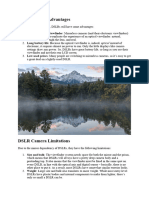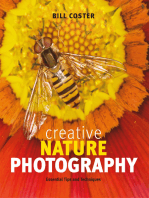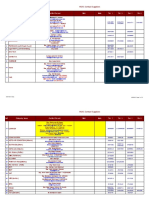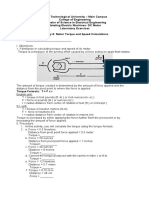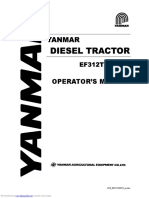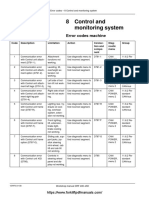Afocal Astrophotography
Afocal Astrophotography
Uploaded by
Walter D S LimaCopyright:
Available Formats
Afocal Astrophotography
Afocal Astrophotography
Uploaded by
Walter D S LimaCopyright
Available Formats
Share this document
Did you find this document useful?
Is this content inappropriate?
Copyright:
Available Formats
Afocal Astrophotography
Afocal Astrophotography
Uploaded by
Walter D S LimaCopyright:
Available Formats
Afocal Deep Sky Astrophotography
I use a 8.5 inch F6 Newtonian on and HEQ5 mount plus Olympus 2020Z camera. I wrote this stuff
because I got fed up with reading on various forums how it was a waste of time imaging anything
except the moon and planets with a cheap digital camera. I guess if you have much a smaller
telescope aperture you might struggle to do much with the limited exposure times available to non-
DLSR digital camera. But I have never tried, so I don't really know!
Update for 2008 onwards: I now have a 4 inch F6.5 Celestron Nexstar on a GOTO alt-az mount - it
works just as well for afocal imaging as the 8.5 inch - better on large objects in fact.
Update for 2010 onwards: well, I finally went down the DSLR route and started prime focus imaging.
I did seriously consider a new P&S, but it is now very difficult (almost impossible in fact) to find one
with a threaded lens.
Anyway, for what its worth, here is how I used to do it ...
Pros and Cons of Point&Shoot digital cameras cf DSLRs
Pros
Cheap
Light
Easy to vary image scale
Focus position similar to visual
Fixed lens, so no problems with
dirt falling on the CCD
Cons
Cameras allegedly noisier than DLSRs (not
sure this is true!)
*
Light loss & optical distortions due to
camera lens/eyepiece
Limited exposure times (can be overcome
by stacking)
Small effective camera apertures don't full
cover eyepiece exit pupil
**
*
You will often see it said that DSLRs are better because their CCDs have larger pixels which can hold many more photons
and hence reduce the random noise. For everyday photography this is true - but the reason this works is that DSLRs have
much bigger lens apertures and so collect much more light for a given exposure and F-number. In astronomy, the amount of
light is fixed by the telescope not the camera lens, so this advantage vanishes (except see below!).
**
Most compact digital cameras have very small apertures on their wide field setting, e.g. my 2020Z has a 6mm focal length
at f2 => 3mm aperture. A low power eyepiece for optical viewing may have, say, a 6mm exit pupil, so I am effectively limiting
my telescope to one of half the aperture. Zooming in, either with the camera or the eyepiece, helps (gives a larger camera
aperture or smaller exit pupil) but, of course, reduces the field of view on the sky.
How-To Image DSOs
The basic idea is to take lots of short exposures and digitally add them together in a computer. Roughly
speaking, this is just as good as taking one long exposure. You will still need a mount which can track though
(for the length of exposures we are talking here, either a cheap motor driven alt-az or an equatorial mount will
be fine). The camera needs fastening securely and square on to the eyepiece. Ideally, the lens aperture should
be about the same size as the exit pupil of the eyepiece and be positioned at a distance equal to the eye relief
of the eyepiece. There are various devices around to assist with this, but there is no real substitute for a
threaded lens screwed on to a threaded eyepiece! Unfortunately there are not many compact digital cameras
with threaded lenses. A camera with manual control is almost essential and you will need some way of
triggering the shutter remotely. Focus both telescope and camera on infinity. Take various test exposures to
refine the focus (this means examining the shots on computer - I have never found looking through the camera
LCD successful). Choose a target - exposure for as long as you can (or as long as your mount will allow).
Repeat. At regular intervals take dark exposures in order to remove hot pixels from the images.
Camera
There are several desirable features of the Olympus 2020Z which lend themselves to astrophotography.
Whether one can still find them in more modern cameras is debatable:
1. Infra-red remote control of the shutter
2. Threaded lens
3. Full manual control
4. 16sec maximum exposure time
5. F2 lens
6. 4 micron pixels
Mounting
With a threaded lens the 2020Z can be attached securely to an eyepiece by means of a T2 adapter which
fastens to the top of the eyepiece with three metal screws and an Allen key. This assumes the eyepiece has a
suitable groove in which to site the adapter. For eyepieces without I have used a Scopetronics adapter which
simply holds the eyepiece with nylon screws. However this proved very difficult to align correctly, especially
in the cold and dark! If you do not have a threaded camera lens (and most modern compacts - but not all -
do not) then you will need to look at one of the proprietary devices available (there are some specifically for
astronomy, but also try looking up 'digiscoping' on the WWW - people who photograph birds have been
doing this sort of thing for ages). Whatever you choose, make sure to make a light tight seal between the
camera and the eyepiece.
Mounting kit disassembled - eyepiece;
T2 adaptor; Olympus CLA-1 adapter
plus 43mm-T2 step down (up?) ring.
Eyepiece with T2 adaptor attached.
Fully assembled, ready to screw onto
the camera.
Vignetting, or not?
You will read on the web that afocal imaging is usually a waste of time due to vignetting. What is meant here
is the fact that the camera images the end of the eyepiece, and so you get a circular field of view (There is
also optical vignetting, where the intensity of the sky background falls off towards the edge of an image. This
is a separate issue and affects all telescopes/cameras to some extent). Personally I do not consider this a
problem. What really matters is pixel scale and total field of view. After all, telescopes give circular images,
and cameras take rectangular pictures, so one can never match the two perfectly. My preference is to see the
whole field of view of the telescope, which means that I consider a perfectly matched combination of
eyepiece and camera to be one where the narrow width of chip is just filled by the image from the eyepiece.
The full 2020Z image of the twilight sky (M44 actually),
using a 32mm eyepiece. The view here is almost identical to
what you would see by eye through the eyepiece. I consider
this a good match between camera and telescope.
The combination I use of F6 Newtonian, 32mm eyepiece and 2020Z camera, gives about 3'' per pixel (the
pixels are 4 microns), and field about 1 deg across, which I reckon is just about right for most of the brighter
galaxies, clusters and nebulae. There may be an issue with the camera aperture being too small for the exit
pupil - I have still to investigate this. It is possible to zoom in with the camera, or change to a higher powered
eyepiece, to get a smaller number of arcseconds per pixel, although this puts more demands on the tracking.
Exposure times
Another comment you often see relates to the short maximum exposure times offered by non-SLR digital
cameras. It is rare even now to see much more than 16sec offered. However, again, I do not see this as a
problem. In my light-polluted skies, exposures much longer than this will simply be bright orange! It also
means my mount doesn't have to track particularly accurately.
Curiosity: Two times eight does not equal sixteen!
Left: the sum of two 8sec exposures on the Orion nebula. Right: One 16sec exposure take at the same time with the same
ISO. The colours (and saturation) are clearly not the same!
I prefer the 8sec shots, but with the 2020Z there is a constant readout time penalty with each exposure of a
few seconds, so observing with 8sec or shorter times is very inefficient.
ISO
When I started I just set the camera to maximum ISO (400 for the 2020Z) and got on with it. However,
digital cameras are not like film cameras, and ISO is rather a fake concept. In 16secs you get 16secs worth
of photons on the CCD, whether ISO100/200 or 400. Changing ISO just multiplies up the voltage before it
goes through the A/D converter, so although you get brighter images (i.e. larger numbers) at ISO400 it is not
clear that the signal-to-noise ratio is any better. In fact, if the read noise increases it might be worse. What has
become clear to me is that the colour balance is much more `natural' at ISO200 than 400 (which tends to
give too much red/orange - and even if you adjust the colour balance you still end up with a predominance of
red noise in the image.), so at the moment I take all my frames at ISO200 [I changed my mind on this one
and moved back to ISO400, but having read more about unity gain (see below) I think more tests are
needed. Another issue I hadn't considered before is that of colour resolution at low signal - with only
one or two counts from an object, unless it is very strong coloured, it is going to come out grey, so in
this situation higher ISO is potentially better.]. This, of course, could just be a feature of the 2020Z.
Unity gain: in fact, theoretically, the best ISO to use is that where the gain is set so that one electron == one
count. A higher ISO clips the bright portions of the images, whereas a lower ISO drops the faintest areas (i.e.
doesn't fully sample the noise). Assuming 12 bits in the A/D converter, then for compact cameras this
seems to be ~ISO100 whereas for DSLRs it is > ISO1000
*
(see e.g. the ClarkVision site). However, if like
me you use jpegs, which are limited to 8 bits, it is not at all clear where unit gain occurs (it is not a figure that
manufacturers seem to want to give you!) - it might be at 16x these ISOs! In principle, this could make you
think that DSLRs have much lower noise levels than compact cameras, because if you compared at the same
ISO, then the gain, and hence the noise, is about 10x higher in a compact camera. However, so is the
signal, so the S/N ratio really the same!! . If you can retrieve RAW images with12 or more bits (as with
most DSLRs but very few compacts) then you do better here.
*
If you are wondering why, then remember that camera manufacturers have to ensure that e.g. '1/250 sec, F8, ISO100 in
bright sun' gives roughly the same final exposure (e.g. the histogram in the same place) in any kind of camera (otherwise
normal, daytime photography would be a nightmare!). But DSLRs collect many more photons (about 10x in fact) due to their
larger lenses, so to ensure the same final count level in the image the gain has to set so that there are 10x as many electrons
per ADU in a DSLR than in a compact.
Left: 3x16s ISO200 on M31 (dark-subtracted), with the intensities multiplied by 2 to mimic ISO400. Right: 3x16s IS400
(dark-subtracted) taken on the same night. Both frames have had their gamma levels adjusted (identically) to bring out
the background. The ISO400 shot is possible slightly deeper, but has an annoying pink tinge.
File type
OK, so I use jpegs - I probably shouldn't. But they are smaller and much easier to save and handle
afterwards, and my camera only offers tiffs as an alternative. These are less compressed, but I am not
convinced this makes much difference for the average astro shot. Both formats restrict me to 8-bit images
(numbers from 0-255), which is probably what the A/D converter in the camera is capable of. Ideally one
would like more but you probably have to get a DSLR for this (and find some stacking software which
handles 16-bit images)!
Update for 2008: While Comet Holmes was around I tried comparing tiff and jpeg - I couldn't tell the
difference between the final stacked images.
Dark frames
The main reason exposure times are limited, of course, is that digital cameras in general, and (maybe) point
and shoot ones in particular, suffer from excessive noise levels in long exposures (dark current, or 'hot pixels'
are the problem in fact). You will never be able to image faint objects such as galaxies and nebulae if you do
not subtract dark frames from your images. As I have light-polluted skies, I kill two birds with one stone and
use `sky' darks. I rest a circular diffusing screen over the spider (made from one of those opaque A4 plastic
pouches you can get at stationary shops) and take an exposure of the same length as the image exposure.
Top end of telescope with and without the opaque mask for taking sky darks. I have two masks, but usually only use
one.
As the hot pixel count seems to vary dramatically with time (camera temperature I assume), I usually take
four 16sec image exposures followed by one dark and use that dark only for those four exposures.
Subtracting the dark from the image frame not only removes the hot pixels, but also the sky background
glow.
Update for 2008: I have now decided the best way to remove dark current and the background sky at the
same time is to take (~10) randomly positioned sky shots close to the object being observed and median
combine them in DSS to form a master 'skydark'. The median combine gets rid of the stars and just leaves
the background. This works pretty well, and I can now get away with, say, ten 16sec shots in row, rather
than the four I was doing before.
Two 16s images of M13 taken on the same night width identical camera settings. Left, after the camera had been idle for
about 5mins; right, after about 15mins of continuous shooting. (This is with a 7-21mm zoom eyepiece set at ~15mm - the
field of view with this eyepiece does not quite fill the smaller dimension of the ccd.)
Left: 16s `sky' dark frame, taken with a diffusing screen over the end of the telescope tube. Right: the result of
subtracting the dark from the noisy M13 frame shown above. The display levels are identical for all four images
(although adjusted from 'raw' to display better on the screen).
The effect of subtracting the dark is pretty dramatic, although clearly all those hot pixels must have some
detrimental effect on the image, and it is better to start with less noise in the first place. This could be done if I
was willing to wait a few minutes between each exposure to cool the camera, I guess, but this would make
total imaging times very long (which would require better tracking by the mount).
I work on the principle that whatever you do to an image probably degrades the signal-to-noise, so I never
bother with flats or bias frames (if you do insist on using them, note that they should have much higher S/N
than the final S/N in your stacked object frames). If I could get away without darks I would. I guess one
option would be to create a hot pixel mask from the dark frames and just use that when stacking the images,
but then the sky background would have to be removed somehow, and I have never found any software
which did this to my satisfaction.
There are a couple of other sources of noise:
readout noise: each time your picture goes through the A/D converter a fixed amount of noise is
added. So in principle it would be better to expose for longer rather than add up lots of shorter
exposures. However, readout noise seems very low for my camera and is not really an issue (this might
not be true if I observed from a really dark site or had RAW data).
photon noise: in the end, physics limits the maximum signal-to-noise you can get to N/sqrt(N), where
N is the number of photons you detect. This is why stacking frames works, as it increases N (as does
exposing longer, or using a bigger telescope, or a more efficient CCD).
Focusing
... is a nightmare! I have a helical focuser, which makes life a little easier - I take a series of shots, rotating the
focus by roughly 30deg each time. These then have to be examined on the computer (taking the media card
out without disturbing the camera) and the best angle chosen. The trouble is that when slightly off focus I find
it is that stars at the edge of the field which go off first - this means that to achieve best focus you need a 1deg
field with bright(ish) stars covering the whole area. This is not always easy to find, although a decent Messier
star cluster can help. Focusing on a bright star through the camera LCD appears not to set the correct focus -
I have no idea why.
The other thing apparent with my setup is that the field is not astrometrically flat, even when in focus (certainly
not when slightly off focus). i.e. the image scale varies across the field. This means that if the image moves
much between exposures it becomes very difficult to stack (see below), and images taken in different
observing runs are almost impossible to stack!
Stacking images
The only way to take images of deep sky objects when you are limited to 16sec sub exposures is to digitally
stack (well, average) many of them together. There are many software packages out there to do this. I used
to do it all manually in GIMP, but now I often use Registax, or a combination of both. My suspicion is that the
best images come from dark subtracting each frame individually in GIMP, then combining in Registax. Using a
`master' dark, formed by averaging all your darks together first, doesn't seem to work as well. I recommend
some form of clipping or medianing, rather than straight averaging. Some hot pixels always sneak through.
With my setup, it pays to keep your individual shots pointing as accurately as possible in the same direction
with the same rotation angle, otherwise you will find that image distortions at the edges of the field become
noticeable.
This stacked, 7 min image of M71 shows the distortions you
get at the edges if you stack images which are not quite
aligned on the same centre. This is made much worse if you
are slightly out of focus (which this probably was!).
Update for 2008: I now use the excellent DSS for stacking, whenever possible. This will correct for (much
of) the distortion at the edge of the images.
So how may do you stack? Well as many as you like really - remember that if your noise is dominated by
photon statistics, then it takes about 6x the exposure to go 1 mag deeper. So far I haven't tried more than
about 15mins worth of exposure - although remember this probably takes 45 mins actual time. In principle
one could just keep going, but the tracking starts to wander and I would need to keep recentering the object.
Also, it gets very boring and very cold, and once the camera batteries go flat that's it, because the focus is
bound to change slightly when the camera shuts down and restarts (the lens on the 2020Z physically retracts),
even if you don't take it off the telescope.
The dramatic effect of stacking 40 16sec images of M13
together. I confess there as been some tweaking of intensity
levels here to bring out the full glory of the cluster!
So how faint can you go? Well, I have detected galaxies as faint as 14th magnitude in 15mins from my garden
(with the moon up as well). I have yet to try from a dark site, where I would expect to do much better.
You can see some examples of my pictures here (with the 8.5inch) and here (with the 4 inch).
You might also like
- Free DSLR Beginners GuideDocument18 pagesFree DSLR Beginners GuideMichael Zhang56% (18)
- Photography 101: The Digital Photography Guide for BeginnersFrom EverandPhotography 101: The Digital Photography Guide for BeginnersRating: 4.5 out of 5 stars4.5/5 (12)
- SLD 31.05.2019 PDFDocument1 pageSLD 31.05.2019 PDFCBNo ratings yet
- Metor 6M Maintenance Manual: P/N 92102928 REV. 6Document40 pagesMetor 6M Maintenance Manual: P/N 92102928 REV. 6Stoyan Georgiev100% (1)
- Cause Effect MatrixDocument5 pagesCause Effect MatrixOQC PetroleumNo ratings yet
- DigitalDocument5 pagesDigitaldivfxNo ratings yet
- Notes Still Photography 106Document35 pagesNotes Still Photography 106Diya KapoorNo ratings yet
- Planetary Imaging Comparison Webcams Vs DSLRs Vs Planetary CamsDocument8 pagesPlanetary Imaging Comparison Webcams Vs DSLRs Vs Planetary CamsDim KeNo ratings yet
- Terms in PhotographyDocument4 pagesTerms in Photographytanisha shokeenNo ratings yet
- DSLR VS MirrorlessDocument8 pagesDSLR VS MirrorlessSoumya DeepNo ratings yet
- The Canon Rebel t6 GuideDocument16 pagesThe Canon Rebel t6 GuideJosh WearingNo ratings yet
- Long Exposures Capturing The Passage of TimeDocument7 pagesLong Exposures Capturing The Passage of TimeFrank EndresNo ratings yet
- Unit One-Introduction To Digital CamerasDocument3 pagesUnit One-Introduction To Digital Camerasapi-442506422No ratings yet
- Astrophotography A Guide To Shooting The StarsDocument17 pagesAstrophotography A Guide To Shooting The StarsmindocideNo ratings yet
- Scanning Thousands of Old SlidesDocument14 pagesScanning Thousands of Old SlidesMarcello PeressiniNo ratings yet
- C - Mount Lens For M4 - 3Document33 pagesC - Mount Lens For M4 - 3kwok hang TongNo ratings yet
- Creative Nature Photography: Essential Tips and TechniquesFrom EverandCreative Nature Photography: Essential Tips and TechniquesRating: 3 out of 5 stars3/5 (1)
- SKF Pulp and Paper PracticesDocument24 pagesSKF Pulp and Paper PracticesSanjeevi Kumar SpNo ratings yet
- Astrophotography by Jerry Lodriguss PDFDocument27 pagesAstrophotography by Jerry Lodriguss PDFPavel100% (1)
- Fluorescent Mineral PhotographyDocument11 pagesFluorescent Mineral PhotographyNathanCookNo ratings yet
- Outdoor Photographer - 12 Essential Rules (Photography) PDFDocument0 pagesOutdoor Photographer - 12 Essential Rules (Photography) PDFcelblackNo ratings yet
- Astro Imaging With Digital CamerasDocument7 pagesAstro Imaging With Digital CamerasbirbiburbiNo ratings yet
- The Canon Rebel t7 2000d GuideDocument17 pagesThe Canon Rebel t7 2000d Guidehwei yo0% (1)
- Basic PhotographyDocument4 pagesBasic Photographyιωαναθαν ρααγασNo ratings yet
- Using An Inexpensive Digital Camera To Photograph Mars-Analog Materials at The Scale of The Mer Microscopic Imager, and at Other Scales. D. M. BurtDocument2 pagesUsing An Inexpensive Digital Camera To Photograph Mars-Analog Materials at The Scale of The Mer Microscopic Imager, and at Other Scales. D. M. BurtdrzeusNo ratings yet
- 23 Powerful Tips For Successful Fireworks PhotographyDocument21 pages23 Powerful Tips For Successful Fireworks PhotographymalabaranjaNo ratings yet
- Digitizing 35mm Film at HomeDocument7 pagesDigitizing 35mm Film at HomeMamu Shaddi backupNo ratings yet
- Guide To AstrophotographyDocument28 pagesGuide To Astrophotographydivfx100% (1)
- COMPUTER PhotographyDocument22 pagesCOMPUTER PhotographyKhate VargasNo ratings yet
- Effective Photography PDFDocument22 pagesEffective Photography PDFWill SnyderNo ratings yet
- Nikon Tseries CloseupDocument5 pagesNikon Tseries Closeupdergi100% (1)
- Equivalent Focal Length and Field of ViewDocument9 pagesEquivalent Focal Length and Field of ViewImafighter4HimNo ratings yet
- Camera Settings GuideDocument16 pagesCamera Settings GuidemoustafahammadNo ratings yet
- CCTV Lens TerminologyDocument2 pagesCCTV Lens TerminologyAabhishek BeezeeNo ratings yet
- The New Photomicrography: Peter EvennettDocument10 pagesThe New Photomicrography: Peter EvennetttmdcorpNo ratings yet
- Exemplary ArtistDocument5 pagesExemplary ArtistYanyan SerranoNo ratings yet
- Hands-On With The Canon EOS 300D Digital Rebel: by Michael R. Tomkins, News EditorDocument5 pagesHands-On With The Canon EOS 300D Digital Rebel: by Michael R. Tomkins, News EditorkichutesNo ratings yet
- Into To PhotographyDocument58 pagesInto To PhotographyKuldeep KuldeepNo ratings yet
- A Technical Guide To Advance PH - Elizabeth FrasersDocument94 pagesA Technical Guide To Advance PH - Elizabeth FrasersRazvan Scarlat100% (2)
- What Lenses Are: Types of Zoom LensesDocument12 pagesWhat Lenses Are: Types of Zoom Lensesandrei neagNo ratings yet
- Batteries Capacitor: The Main Parts of A Digital CameraDocument14 pagesBatteries Capacitor: The Main Parts of A Digital CameraPanwar Suraj100% (1)
- 10 Camera ControlsDocument20 pages10 Camera ControlsJulianne Bsc100% (1)
- LensesDocument7 pagesLensesStephanieNo ratings yet
- Collier's Quick Tutorial On Night PhotographyDocument14 pagesCollier's Quick Tutorial On Night PhotographyCarl VonNo ratings yet
- Basic Camera Techniques: Lens LengthsDocument64 pagesBasic Camera Techniques: Lens Lengthsnabieu foday kpangbavieNo ratings yet
- Fast Track To Creating Stunning ImageryDocument19 pagesFast Track To Creating Stunning Imageryroopesh2190% (1)
- Understanding IP Camera SpecificationsDocument7 pagesUnderstanding IP Camera SpecificationsErnesto ChinchillaNo ratings yet
- Photographer's Companion - User GuideDocument96 pagesPhotographer's Companion - User GuideAntonio Jorge ValerioNo ratings yet
- IDigBioImagingGeneralEquipmentRecommendations1 0Document17 pagesIDigBioImagingGeneralEquipmentRecommendations1 0AbeyMulugetaNo ratings yet
- 12 Essential Facts, Formulas, and Photographic Rules: The OcalDocument1 page12 Essential Facts, Formulas, and Photographic Rules: The Ocalopenid_Ds8hAkazNo ratings yet
- Engadget Primed: What Is Aperture, and How Does It Affect My Photos?Document9 pagesEngadget Primed: What Is Aperture, and How Does It Affect My Photos?Ishu ShresthaNo ratings yet
- Exposures, ISO's, Apertures and Shutter Speeds, Oh My!Document8 pagesExposures, ISO's, Apertures and Shutter Speeds, Oh My!masdipoNo ratings yet
- Digital Video Crop ModeDocument8 pagesDigital Video Crop ModestefanvukNo ratings yet
- Learning Digital SLR PhotographyDocument79 pagesLearning Digital SLR Photographyhny10739100% (1)
- Beginners Photography GuideDocument37 pagesBeginners Photography Guidewgibson1No ratings yet
- CameraDocument6 pagesCamerazia091No ratings yet
- Basic PhotographyDocument20 pagesBasic Photographyfiza_fazalNo ratings yet
- Cinematography Course NotesDocument29 pagesCinematography Course NoteslysysujyNo ratings yet
- Up Close PDFDocument90 pagesUp Close PDFJaime Fernández100% (2)
- Quack Autumn 200iDocument10 pagesQuack Autumn 200iKauan Daniel SantosNo ratings yet
- Spare Parts List: Centrifugal Pumps CP 0020Document16 pagesSpare Parts List: Centrifugal Pumps CP 0020ROBINNo ratings yet
- 3472 Vol 2b-Pac Tech.-Spec.Document123 pages3472 Vol 2b-Pac Tech.-Spec.Satadal LahiriNo ratings yet
- Suppliers Fax & ContactsDocument73 pagesSuppliers Fax & ContactsmostafaabdelrazikNo ratings yet
- Lab Exercises 8Document6 pagesLab Exercises 8Alo, Monique Marie A.No ratings yet
- Plastic Painting Body Parts (ABS)Document16 pagesPlastic Painting Body Parts (ABS)jpabloextNo ratings yet
- Micro Project Report: Title:Characterstics of TRIACDocument14 pagesMicro Project Report: Title:Characterstics of TRIACgaikwad vijayNo ratings yet
- Yanmar Diesel Tractor EF312T Operator's ManualDocument70 pagesYanmar Diesel Tractor EF312T Operator's ManualBuba benNo ratings yet
- Hy Gain AntenaDocument7 pagesHy Gain AntenaIrwan Wiradinata SondaNo ratings yet
- Plano Electrico Motoniveladora 16MDocument6 pagesPlano Electrico Motoniveladora 16MMiguel Anibal Mejia Bravo100% (1)
- Ppe PDFDocument1 pagePpe PDFテレブリコ ジェファーソンNo ratings yet
- 1 Howard Buys A Tablet Computer.: Turn OverDocument4 pages1 Howard Buys A Tablet Computer.: Turn Overahmadyusufhz3No ratings yet
- Half Masks (7700 & 5500) Series Data Sheet Eng-Rev-00Document2 pagesHalf Masks (7700 & 5500) Series Data Sheet Eng-Rev-00asesor2.ctgnaNo ratings yet
- MilingDocument18 pagesMilingKasar nagib 2002No ratings yet
- Accelerometer Application Focus On Seismic Sensors: Home Rental Excitation Electronics Industrial NDTDocument2 pagesAccelerometer Application Focus On Seismic Sensors: Home Rental Excitation Electronics Industrial NDTLake HouseNo ratings yet
- AccessoriesDocument31 pagesAccessoriesLuke ArandidNo ratings yet
- Avr Drawing - KiDocument28 pagesAvr Drawing - KiPradeep SivakumarNo ratings yet
- Worksheet-1.2: To Study Different Parts of MicroscopeDocument5 pagesWorksheet-1.2: To Study Different Parts of MicroscopeTej pattaNo ratings yet
- Kalmar DRF 400 450 Forklift Trucks Error Codes & Wiring Diagrams PDFDocument223 pagesKalmar DRF 400 450 Forklift Trucks Error Codes & Wiring Diagrams PDFGabriel100% (1)
- FLEX-Dispensing-Hot-Cell - Tema SinergieDocument2 pagesFLEX-Dispensing-Hot-Cell - Tema SinergieAnna OlszewskaNo ratings yet
- Spare Parts Manual CP30 440V 60Hz File-IDocument77 pagesSpare Parts Manual CP30 440V 60Hz File-Ikomalinternational5No ratings yet
- Datenblatt F20 - EnglischDocument1 pageDatenblatt F20 - EnglischNahid RahmaniNo ratings yet
- ESPglobal To VCI-142 DrawingDocument1 pageESPglobal To VCI-142 DrawingRonald LlerenaNo ratings yet
- G0000070Document64 pagesG0000070tinduongNo ratings yet
- Power System ProtectionDocument3 pagesPower System Protectionyaschalew ayeleNo ratings yet
- Samsung GT-i9100 Disassembly ManualDocument4 pagesSamsung GT-i9100 Disassembly Manualbradu2002alex9211No ratings yet
- Oboe Gouger User GuideDocument3 pagesOboe Gouger User Guidekyanagisawa100% (1)
- Series230 Ats c1000 Controller Manual v230 20180115Document22 pagesSeries230 Ats c1000 Controller Manual v230 20180115aarian100% (1)









